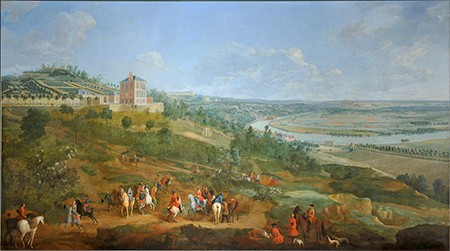My fellowship at casva was devoted to researching and writing a chapter of my book “Noble Beasts: Hunters and Hunted in Eighteenth-Century French Art.” “Noble Beasts” rethinks the history of early eighteenth century art by placing hunting art, generally understood as a minor, and slightly embarrassing, mode of representation, at the center of visual and political culture. In representations of the hunt, animal bodies rival or supplant human bodies, directly contradicting the theoretical priorities of the academy and offering viewers a kind of delectation far removed from the lighthearted pastorals, erotic mythologies, or sophisticated fêtes galantes generally studied by historians of early eighteenth-century French art. At this crucial moment in French history, when absolute monarchy existed in tension with noble and nonnoble elites and the Enlightenment was eroding old certainties about selfhood and society, hunting art insisted on the delights both of the senses and of the creation and destruction of life, against more rational forms of visual representation, sociability, and governance. “Noble Beasts” confronts its readers with an unfamiliar and often nonhuman version of the rococo, in which the natural world is the stage for human and animal selves acting out violent forms of personal and political sovereignty.
The hunt was in fact one of the most spectacular manifestations of political power in early modern France, training its participants for military officership and enacting elite mastery of the land and its inhabitants. It was, as a 1724 treatise put it, “a noble exercise, and the exercise of nobles.” Eighteenth-century artists and patrons, well aware of its rhetorical potency, used the visual representation of the hunt, from monumental paintings of the royal hunt and animal combat to dog portraits and decorated guns, as a vehicle for their personal and political ambitions.
Of the many modes of hunting art, landscape painting, the subject of the chapter I completed at CASVA, is one of the most literal in its evocation of the mastery of nature and of the nation. The king and his court were particularly fond of hunt-themed landscape paintings, which combined the pursuit of animals with portraits of the royal entourage and panoramic views of the countryside and of royal residences. The master of this mode of representation was Pierre-Denis Martin (1673–1742), who as an official royal painter churned out scores of paintings for the king and the princes of the blood. My work at casva examined the problem of the hunt landscape through the lens of a monumental Martin painting of suburban Paris executed sometime in the late 1720s or early 1730s—a painting notable for its peculiarity as a landscape and as a representation of the hunt. Unlike most images of this type, it depicts neither the king nor a royal domain, nor does it have an apparent architectural focus. Its protagonists are women rather than men; the assembled hunting party is distinguished mostly for its disorganization; and the quarry is nowhere to be seen. The commissioner was a disgraced but still extremely wealthy former army contractor whose modest rental property serves as a pretext for the composition.
Neither Martin nor his patron seems to have been interested in making the usual claims about the pursuit of animals or the concomitant human domination over nature. This is not a sign of a shortcoming of the artist or the patron. Instead, I argue, this painting should be understood as appropriating the well-worn conventions of the hunting landscape to promote a different kind of personal and political sovereignty: one that was grounded in new money, in financing the army rather than leading it into battle, and in the suburbs rather than the king’s hunting domains. My research situates Martin’s painting and its visual rhetoric in the history of hunting art and of landscape painting but also in the cartographic tradition, the world of property law, and the political struggles of the regency and early reign of Louis xv. Through an analysis of Martin’s and his client’s upending of pictorial and political norms, I account both for the royal uses of hunting art and for the genre’s sly subversion by nonnoble elites. Martin’s painting is, I argue, less an assertion of authority than a celebration of personal and political freedom and of the possibilities of picture-making.
